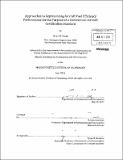| dc.contributor.advisor | R. John Hansman. | en_US |
| dc.contributor.author | Yutko, Brian M. (Brian Matthew) | en_US |
| dc.contributor.other | Massachusetts Institute of Technology. Dept. of Aeronautics and Astronautics. | en_US |
| dc.date.accessioned | 2011-11-18T20:59:40Z | |
| dc.date.available | 2011-11-18T20:59:40Z | |
| dc.date.copyright | 2011 | en_US |
| dc.date.issued | 2011 | en_US |
| dc.identifier.uri | http://hdl.handle.net/1721.1/67199 | |
| dc.description | Thesis (S.M.)--Massachusetts Institute of Technology, Dept. of Aeronautics and Astronautics, 2011. | en_US |
| dc.description | Cataloged from PDF version of thesis. | en_US |
| dc.description | Includes bibliographical references (p. 79-80). | en_US |
| dc.description.abstract | Increasing concern over the potential harmful effects of green house gas emissions from various sources has motivated the consideration of an aircraft certification standard as one way to reduce aircraft C02 emissions and mitigate aviation impacts on the climate. In order to develop a commercial aircraft certification standard, a fuel efficiency performance metric and the condition at which it is evaluated must be determined. The fuel efficiency metric form of interest to this research is fuel/range, where fuel and range can either be evaluated over the course of a reference mission or at a single, instantaneous point. A mission-based metric encompasses all phases of flight and is robust to changes in technology; however, definition of the reference mission requires many assumptions and is cumbersome for both manufacturers and regulators. An instantaneous metric based on fundamental aircraft parameters measures the fuel efficiency performance of the aircraft at a single point, greatly reducing the complexity of the standard and certification process; however, a single point might not be robust to future changes in aircraft technology. In this thesis, typical aircraft operations are assessed in order to develop evaluation assumptions for a mission-based metric, Block Fuel divided by Range (BF/R), and an instantaneous metric, incremental fuel burn per incremental distance (inverse Specific Air Range (1/SAR)). Operating patterns and fuel burn maps are used to demonstrate the importance of mission range on fleet fuel burn, and thus the importance of a properly defined range evaluation condition for BF/R. An evaluation condition of 40% of the range at Maximum Structural Payload (MSP) limited by Maximum Takeoff Weight (MTOW) is determined to be representative for the mission-based metric. A potential evaluation condition for 1/SAR is determined to be optimal speed and altitude for a representative mid-cruise weight defined by half of the difference between MTOW and Maximum Zero Fuel Weight (MZFW). To demonstrate suitability as a potential surrogate for BF/R, correlation of 1/SAR with BF/R is shown for the current fleet, and a case study of potential future aircraft technologies is presented to show the correlation of improvements in the 1/SAR metric with improvements in BF/R. | en_US |
| dc.description.statementofresponsibility | by Brian M. Yutko. | en_US |
| dc.format.extent | 90 p. | en_US |
| dc.language.iso | eng | en_US |
| dc.publisher | Massachusetts Institute of Technology | en_US |
| dc.rights | M.I.T. theses are protected by
copyright. They may be viewed from this source for any purpose, but
reproduction or distribution in any format is prohibited without written
permission. See provided URL for inquiries about permission. | en_US |
| dc.rights.uri | http://dspace.mit.edu/handle/1721.1/7582 | en_US |
| dc.subject | Aeronautics and Astronautics. | en_US |
| dc.title | Approaches to representing aircraft fuel efficiency performance for the purpose of a commercial aircraft certification standard | en_US |
| dc.title.alternative | Approaches to representing aircraft performance for the purpose of a CO₂ certification standard | en_US |
| dc.type | Thesis | en_US |
| dc.description.degree | S.M. | en_US |
| dc.contributor.department | Massachusetts Institute of Technology. Department of Aeronautics and Astronautics | |
| dc.identifier.oclc | 758677874 | en_US |
